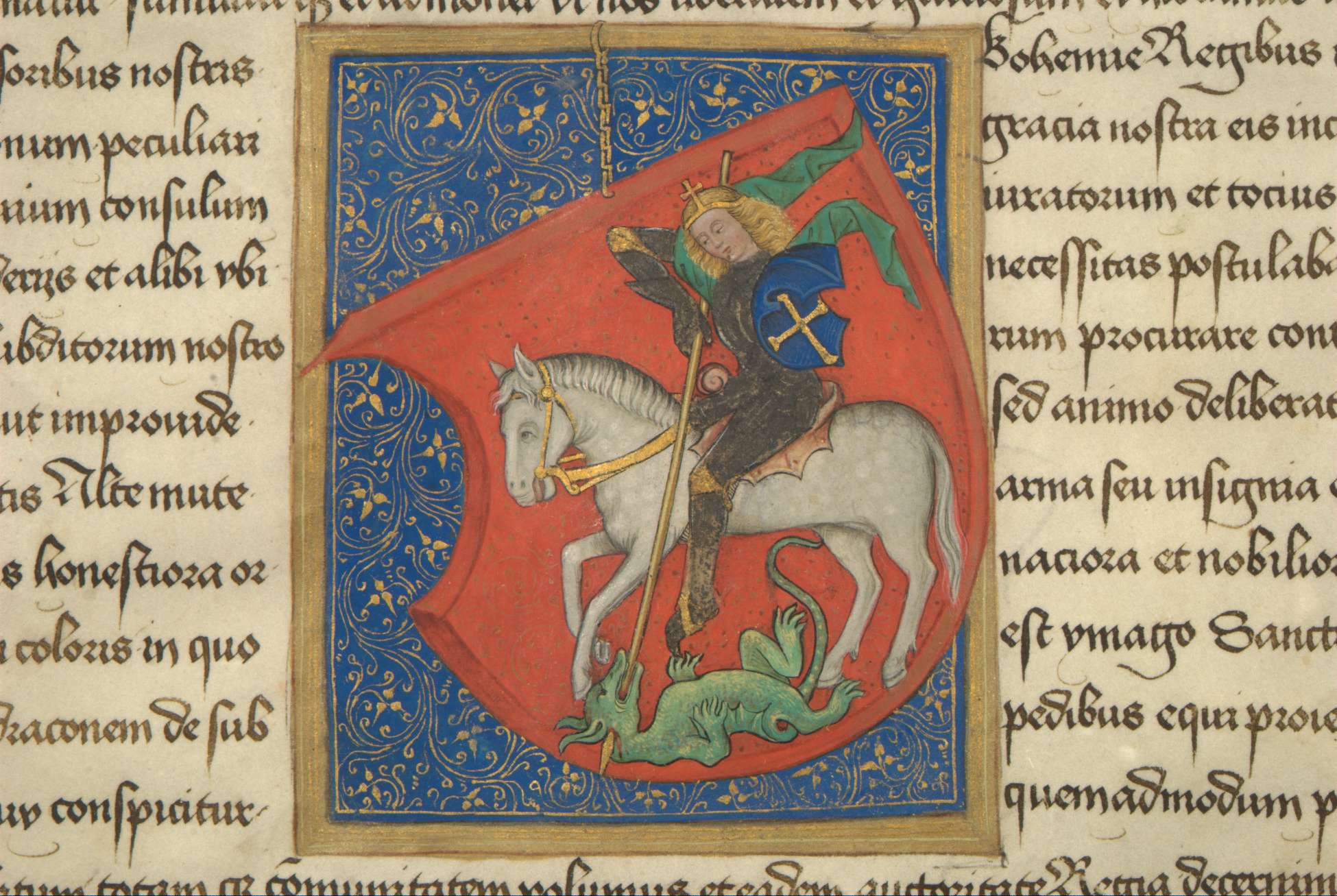
Town of Vysoké Mýto lies above the river Loučná and was founded by King Přemysl Otakar II and as one of the trading centres on the main road between Bohemia and Moravia, the so-called Trstenická stezka (the Trstenice Path), and was inhabited by German settlers. This happened before 1265 when the first written remark about the town appeared. The town had replaced near decades older urban settlement called “Mýto” (“the Toll”) /later “Staré Mýto” (the “Old Toll”)/. The town was named according to the older settlement and adopted the privilege of collecting the toll, i.e. customs duty on goods. Designation “Vysoké” (“High”) probably comes from the location of the new settlement which lay higher than the original “Staré Mýto”. The even ground pattern of the town is one of the main demonstrations of the developed urbanism of the second half of 13th century. The quadrangle square became the centre of business followed by the even street net, area for parish church and minority monastery was defined. Square evenness of the whole town ground could be kept thanks to the formation of country. Stone fortification with three gates was built in stages around the whole town. In the beginning of 14th century a group of dower towns for Czech queens separated. Hradec Králové, Chrudim, Polička etc belonged to this group together with town of Vysoké Mýto. Except from several fees each of nine royal dower towns used to send various presents to the cusine of the king or queen as well as to the high officials, always the best goods of the region. That is why wine from Chrudim, pheasants from Hradec Králové or trout from Mýto were send to Prague according the occasion celebrated. Royal and dower towns had gradually lost their privileges from the 17th century and lost the last old benefits in the half oh 19th century.
The townsmen of Vysoké Mýto became richer and richer thanks to a busy mercantile road. The representative gothic cathedral as well as quality stone fortification and town hall became the pride of the town in the 14th century. Vysoké Mýto was occupied during Hussite Wars several times, first by troops of Praguers and then by troops of orphans, whom the town supported until the defeat of Hussite radicals at the Battle of Lipany. Most of the German patricians left the town during wars and town finally became Czech. Old town hall was probably destroyed and replaced by new building in the east side of square. Religious sites were in most cases devastated, ransacked minority monastery was never reconstructed. Representatives of catholic and town nobility together with delegates of Vysoké Mýto and other royal towns accepted Zikmund Lucemburský as the Czech king. In return he confirmed them all town privileges and donated town of Vysoké Mýto to his wife Barbora. In 1471 the town emblem was reclaimed by King Vladislav Jagellonský which was high prestige at that time. Emblem with St. George on the horse lancing a dragon replaced the original picture of dragon on the old seal. In the 16th century a new period came – a “Golden Era” of Czech towns. Thanks to renewed external trade cloth made in Mýto could be sold abroad and compete with cloth from Litomyšl and Chrudim on Polish and even Ukrainian markets. Knives were also exported. Mýto as the 10th biggest town after capital Prague had 368 houses and by purchasing vast domains equalled local lieges. The favourable economic situation was displayed most distinctly in the building activities of those times, moreover influenced by devastating fires between 1461 and 1517 when more than third of estates was destructed. In the 16th century several stone houses were erected on the square as well as new “town hall”, the Holy Trinity Church, St. Lawrence Cathedral was reconstructed and near a belfry was built. This period of flourishing was interrupted by the defeat of an uprising of the Bohemian estates at a Battle on Bílá Hora (White Mountain) in 1620. Town of Mýto was strictly punished for taking part in the uprising, but even more oppressive were the results of the Thirty Years´ War. In 18th century more devastating fires appeared in the town, in 1774 even 238 houses and some landmarks burned down. New development, especially in the cultural area, came in the 19th century. Czech-language theatre was performed and in 1839 the first Czech public library in East Bohemia was established here. Very soon effort to save historical buildings and movable estates appeared. In 1871 the oldest town museum in the country was founded. By the end of 19th century a substantial revitalisation even of the economy came along. That was the moment of foundation of what were to become the two biggest engineering and machine-building companies. The Sodomka works /1895/ manufactured carriages and later on bus bodies and the Stratílek company /1899/ focused on fire-brigade technology. After the old type of government was abolished in 1849 Vysoké Mýto became a district town and performed this role for the next 111 years until 1960. For 200 years lives of the citizens were influenced by the presence of a military base. The first barrack, stables and training ground were built as soon as in the second half of the 18th century. The 30th infantry regiment of Vysoké Mýto is very famous because in the end of World War I it revolted and fully armed had managed to get back from Italy to homeland. Then, as one of the best organised regiments of the new born republic, it was sent to fight in Slovakia. Between 1968 and 1990 the strong Soviet occupation troops were placed in this military base. After their withdrawal the strategic military function of the town vanished.
The Square of Přemysl Otakar II
 Since the foundation of Vysoké Mýto the unusual large quadrangle square forms the centre of town life. You can access it through twelve streets, two in the corners and one on each side. The area of square was so vast that only one main city circle road could be built inside the town fortification. Across the square, where annual and weekly busy markets were held, so-called Trstenická stezka (The Trstenice Path) led from Prague Gate to Litomyšl Gate. Ten houses were originally erected in the middle of the market-place, later followed by sheds and shelters of craftsmen.
Since the foundation of Vysoké Mýto the unusual large quadrangle square forms the centre of town life. You can access it through twelve streets, two in the corners and one on each side. The area of square was so vast that only one main city circle road could be built inside the town fortification. Across the square, where annual and weekly busy markets were held, so-called Trstenická stezka (The Trstenice Path) led from Prague Gate to Litomyšl Gate. Ten houses were originally erected in the middle of the market-place, later followed by sheds and shelters of craftsmen.
Water supply was provided by two wooden fountains and the redundant water flowed off to large puddle. In the 18th and 19th century the first pavement was installed on the grassy and often muddy market-place surface, the inner buildings were dismantled and thus the largest area of quadrangle square in our country originated. The recent design of mosaic scenes, three summerhouses, sun clock and fountain was created between years 1995-97. In 1714 the Marian column was situated right in the centre point of the square as the remembrance of that year events – peace treaty with the French after long wars over Spanish heritage and plague infection in the town. The column (14 m high) represents pure baroque sculptural style of exceptional calm concept, author is unknown. On the top of the column you can find the statue of The Virgin Mary /Immaculate/, on the base statue of St. John of Nepomuk (with crucifix), St. Joseph, St.Florian (protector against fires and floods) and St. Lawrence (with grid, the patron saint of protection against plague). Wooden and half-timbered houses of the richest townsmen were built around the market-place as first while stone began to be used as more common building material in the 16th century. “Old Town Hall” is one of the oldest stone houses dated 1433 (No. 96, the house with pinnacle and clock). This “big and new rathúz” as it is called in the town chronicle had replaced the original town hall in the centre of the square. The gothic town hall had burned down several times, it was reconstructed in baroque style and in 1828 definitely rebuilt Empire style. In the middle of the 19th century, when the Town Hall was used as the residence of district court, the jail was attached to the back side. Next to the nowadays Town Hall erected in pure functionalism style (1932) you can find “the Mansion house” (Panský dům, orange with two gables, No. 91). It was originally built as renaissance house combined with late gothic by a rich townsman Matěj Piknus in 1536. In the 18th century baroque gables were added including the parget town emblem. The house had changed the owner many times, since 1750 it was used as the barrack, later as a pub and municipality seat. The gable with the Czech lion, placed above the entrance and dated 1536, represents probably the emblem of butchers. Your eye will also be drawn to the neighbouring corner of the square and the neo-renaissance building from 1902, which was originally designed for district municipality (yellow three-storied building with pinnacle, No. 24). You can find the exhibition hall of Jan Juška with decorated ceiling in the former council hall, which is nowadays used for exhibition purposes of the Town Gallery (founded in 1957). The house from the 16th century (yellow, No. 206) is also worth noticing, this interesting building with late gothic cusped portal is situated in front of the fountain. The pink rococo front facade of originally renaissance house with two busts and Hermes head (No. 195) glares in the neighbouring square corner.
St. Lawrence Cathedral
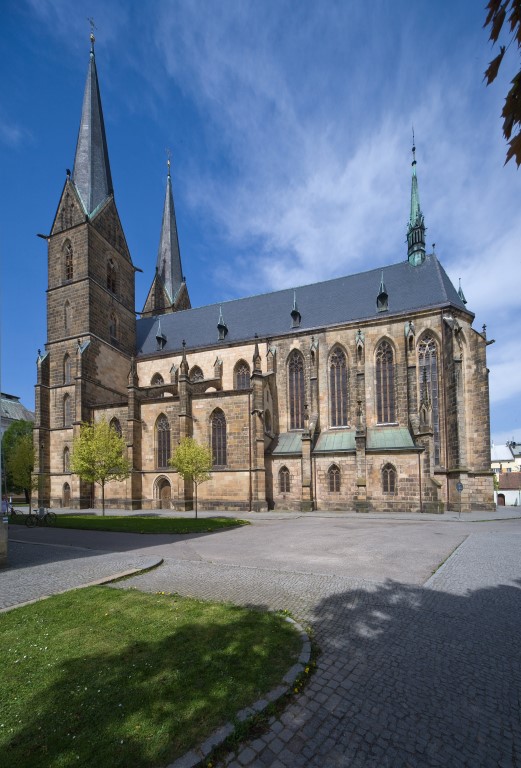 In the beginning of the 14th century the church was promoted to the dean church but its building in the defined place of fortification corner had been taken into account long before, just as the town was founded. There is no information about its original shape but it definitely used to be more moderate and humble. The townsfolk became richer and richer and thus could afford, especially during the peaceful rule of King Charles IV (1346-78), building of monumental sanctuary. St. Lawrence Cathedral surpassed the average of that time. In the following centuries it had burned several times and was almost destroyed, fortunately the main expression was saved. The nowadays look of the church is the result of purist restoration from the end of the 19th century,which was mostly led by Fr. Schmoranz and J. Mocker.Once you enter the church through the two-tower front façade, you find yourselves in the spacious triple nave with long chancel. The walls of the church are decorated with impressive Art Nouveau works of art and figural scenes (designed by K.V. Mašek). In the chancel you can admire the scenes from St. Lawrence’s life and the assumption of Jesus, in the side aisles the scenes symbolizing Přemysl Otakar II and the foundation of the town and personalities connected with church’s restoration (from the left arch. F. Schmoranz, writer A.V. Šembera, Mayor J. B. Tůma, architect J. Mocker and ministry official H. Jireček). The high altar with the painting of the Assumption of Virgin Mary dominates the spacious interior. The painting was finished in 1728 and Petr Brandl is its author. The baroque altar with more things was bought in 1787 from the cancelled Cistercian monastery in Sedlec near Kutná Hora. The painting (7.03 m of height) shows the traditional motif – The Virgin Mary, the protector of Cistercian order, enters the heaven being watched by the amazed apostles gesticulating over her empty grave. The motif continues in the plastic altar’s decorations where John the Baptist is sitting but The Virgin Mary is looking higher at The Holy Trinity and her son. The visitors may be surprised with the painting as it is full of contrasts – intense motion in comparison with floating bodies in heaven,deep shades versus bright colours. This Petr Brandl´s masterpiece is one of the top works of baroque art in East Bohemia. Most of the church mobiliary comes from the recent time. The older decorations were either burned or removed on purpose during non religious times. Late gothic baptistery from 1499 was preserved, cast by Ondřej Ptáček, and you can see it between the chancel and cathedral body. You can also see The Holy Virgin statue from the beginning of the 16th century in the side chapel of St. John the Baptist.
In the beginning of the 14th century the church was promoted to the dean church but its building in the defined place of fortification corner had been taken into account long before, just as the town was founded. There is no information about its original shape but it definitely used to be more moderate and humble. The townsfolk became richer and richer and thus could afford, especially during the peaceful rule of King Charles IV (1346-78), building of monumental sanctuary. St. Lawrence Cathedral surpassed the average of that time. In the following centuries it had burned several times and was almost destroyed, fortunately the main expression was saved. The nowadays look of the church is the result of purist restoration from the end of the 19th century,which was mostly led by Fr. Schmoranz and J. Mocker.Once you enter the church through the two-tower front façade, you find yourselves in the spacious triple nave with long chancel. The walls of the church are decorated with impressive Art Nouveau works of art and figural scenes (designed by K.V. Mašek). In the chancel you can admire the scenes from St. Lawrence’s life and the assumption of Jesus, in the side aisles the scenes symbolizing Přemysl Otakar II and the foundation of the town and personalities connected with church’s restoration (from the left arch. F. Schmoranz, writer A.V. Šembera, Mayor J. B. Tůma, architect J. Mocker and ministry official H. Jireček). The high altar with the painting of the Assumption of Virgin Mary dominates the spacious interior. The painting was finished in 1728 and Petr Brandl is its author. The baroque altar with more things was bought in 1787 from the cancelled Cistercian monastery in Sedlec near Kutná Hora. The painting (7.03 m of height) shows the traditional motif – The Virgin Mary, the protector of Cistercian order, enters the heaven being watched by the amazed apostles gesticulating over her empty grave. The motif continues in the plastic altar’s decorations where John the Baptist is sitting but The Virgin Mary is looking higher at The Holy Trinity and her son. The visitors may be surprised with the painting as it is full of contrasts – intense motion in comparison with floating bodies in heaven,deep shades versus bright colours. This Petr Brandl´s masterpiece is one of the top works of baroque art in East Bohemia. Most of the church mobiliary comes from the recent time. The older decorations were either burned or removed on purpose during non religious times. Late gothic baptistery from 1499 was preserved, cast by Ondřej Ptáček, and you can see it between the chancel and cathedral body. You can also see The Holy Virgin statue from the beginning of the 16th century in the side chapel of St. John the Baptist.
The Belfry
In 1585 a huge renaissance belfry-tower was built in the neighbourhood of the church, because the bells overloaded cathedral’s towers. In 1898, when the St. Lawrence towers were restructured, the bells were put back into its place. Nowadays the belfry is used for the exhibition purposes of the Town Gallery.
The Prague Gate
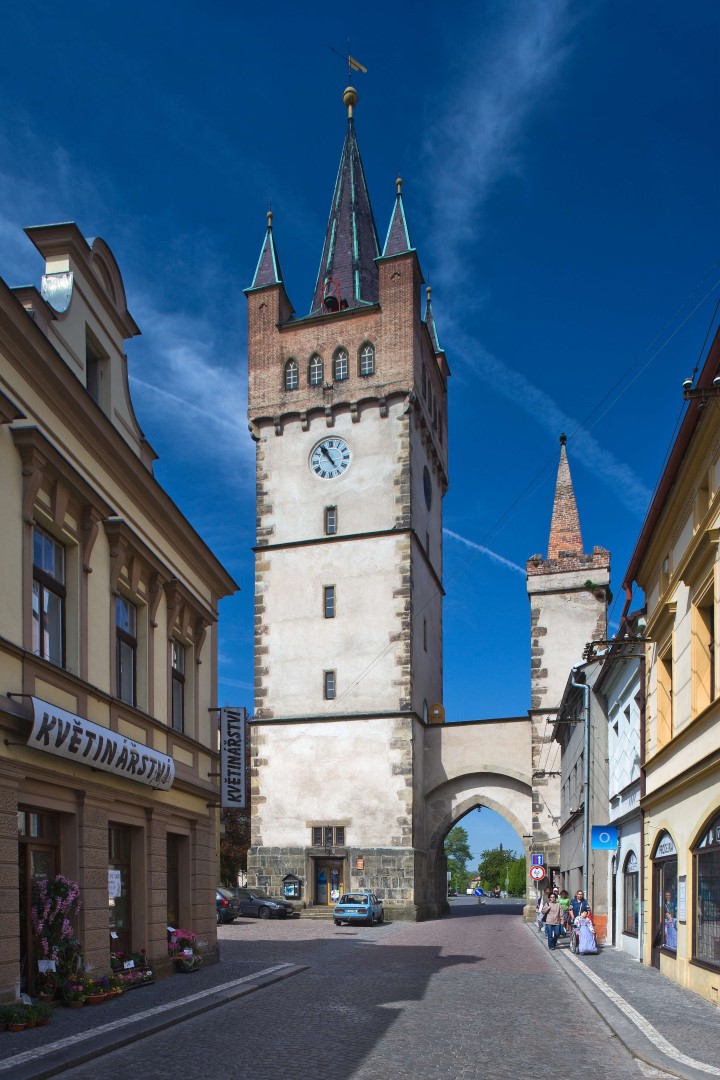 Medieval town fortification built in the 14th century had several defence lines – a loam embankment, a moat, a lower bailey with oillets and a higher main town wall fortified by about 25 flankers and some towers. The town had three gates (later on equipped with double fore gate space) which were named after the direction they headed for – the Prague Gate (sooner Vraclav Gate), the Choceň Gate (Karaska) and the Litomyšl Gate. The fortification step by step had lost its military importance and since the end of the 18th century it had been almost demolished. Some decades later when the care of historical monuments became important, some parts of the town fortification were saved and restored. The Prague Gate belongs to the most preserved defence entries, without the fore gate space. You can enter the big tower only through the caracole of the small tower and the bridge above the gate. The simplest and the oldest type of arch – the so-called “false arch” where each brick overlaps the lower one and thus the space is gradually closed – is worth seeing in the small tower. Nowadays gate design comes from the year 1883 when it was restored according the project of Fr. Schmoranz. The big tower is also used as the observation tower and is open for public. Near the small tower you can see the house called “Na střelnici”, the former seat of riflemen club and after 1900 the Art Nouveau building with M. Aleš´s graffito. The shooting gallery itself can be found in the garden outside the house.
Medieval town fortification built in the 14th century had several defence lines – a loam embankment, a moat, a lower bailey with oillets and a higher main town wall fortified by about 25 flankers and some towers. The town had three gates (later on equipped with double fore gate space) which were named after the direction they headed for – the Prague Gate (sooner Vraclav Gate), the Choceň Gate (Karaska) and the Litomyšl Gate. The fortification step by step had lost its military importance and since the end of the 18th century it had been almost demolished. Some decades later when the care of historical monuments became important, some parts of the town fortification were saved and restored. The Prague Gate belongs to the most preserved defence entries, without the fore gate space. You can enter the big tower only through the caracole of the small tower and the bridge above the gate. The simplest and the oldest type of arch – the so-called “false arch” where each brick overlaps the lower one and thus the space is gradually closed – is worth seeing in the small tower. Nowadays gate design comes from the year 1883 when it was restored according the project of Fr. Schmoranz. The big tower is also used as the observation tower and is open for public. Near the small tower you can see the house called “Na střelnici”, the former seat of riflemen club and after 1900 the Art Nouveau building with M. Aleš´s graffito. The shooting gallery itself can be found in the garden outside the house.
Havlíček´s Park
Information boards with a description of local flora are placed in each town park. The parks were established in the area of collapsed ramparts and moats of medieval fortification. Havlíček´s Park was set after 1900, by that time there used to stand lancer riding halls.
The Theatre of A. V. Šembera
The amateurish theatre has been traditional in Vysoké Mýto since 1825. One hundred years later, between 1924 and 1925, the theatre building was erected in the style of Art Nouveau according the design of Mašek. Theatre of A.V. Šembera, which gained its name in 1929, offers large scale of performance of the local amateur groups or guest groups. The town cinema is placed here as well.
Masaryk’s Park
Masaryk’s Park (originally Rudolph’s Park) replaced the shooting gallery in 1882. Since 1937 the Hussite Church of Czechoslovak Hussite congregation (architect Fr. Truhlář from Vysoké Mýto) has been standing there. Just in front of it on the right side of the way you may notice the concrete study (statue Master Vladislav Srba) of the Czech lion from the end of the 19th century. The Park is verged by the fragments of main bailey, which had been built in the recent houses and end by the Water Tower. The Water Tower belonged to the number of town wall fortifying towers in the corners and may be also somewhere else. In 1768 the Water Tower started to be used as water reservoir, water was run there from the lower set water tower and then transported to the square fountains and some wells in the streets. The Water Tower had two more storeys in the past, which were demolished in 1830.
Tyrš´s Square
In the corner of the town wall, in the place of nowadays Sokolovna building and Tyršovo Square, used to stand the minority monastery, first mentioned in 1290. We do not know its shape and can only guess that the buildings probably were attached directly to the town wall and together with St. Peter and Paul Monastery closed the garth. The monastery was demolished sometimes during the Hussite Wars, may be during the first occupation by the Praguers. The only visible fragments to be seen nowadays are the emblems from the beginning of the 14th century built in the garden wall of Sokolovna building. The main dominant feature of Tyršovo square is represented by the neo-renaissance Sokolovna building from 1901 (architect Fr. Podhajský). In 1912 a memorial to Miroslav Tyrš, the founder of the Sokol movement was built in front of it, in the architecture style of Art Nouveau – the first memorial of Tyrš in the Czech countryside. The west side of the square (next to the Water Tower) is closed by one-storied gable and hipped houses from the beginning of the 19th century. In Sokolovna building court you can find the monastery tower from the end of the 15th century (restored in 1862) of semicircular ground plan, originally open towards town. Together with the Water Tower it is the only preserved wall tower. The set-off in the storey might be the ambit fragment of the main town wall. A short part of the original bailey with oillets and supports was preserved under the tower (accessible from the second side of the Water Tower).
The Museum
The Museum of Vysoké Mýto, the oldest town-administrated museum of the country was established in 1871 by the request of educated miller Karel Richter. More than two hundreds of items given by citizens were collected at once, but the first enthusiasm soon weakened and in 1877 the museum activity was ceased completely. 6 years later a young architect Josef Škorpil took care of the abandoned collection. Later he had also founded and directed the Industrial Art Museum in Pilsner for many years. The collections were placed at the restored Prague Gate and opened for the public. In 1912 the whole museum was moved to the classicistic building of the important local personality, Alois Vojtěch Šembera (1807-1882), Czech language professor in Olomouc, Brno and Wien. As a student he had established the amateur theatre tradition in Vysoké Mýto, later he had founded the town library and town chronicle, he was the author of the first town history and managed to save the fragments of town walls. In 1960 the Museum was changed to a district museum and since 2003 has been serving as the Regional Museum under the Pardubice region. The exhibition of famous car body manufacture Sodomka, includes the unique Aero 50 Dynamik car. Short-time thematic exhibitions can be visited in the house of Šembera, the Museum also takes care of the exhibition of restoration works in Vraclav.
The Choceň Tower
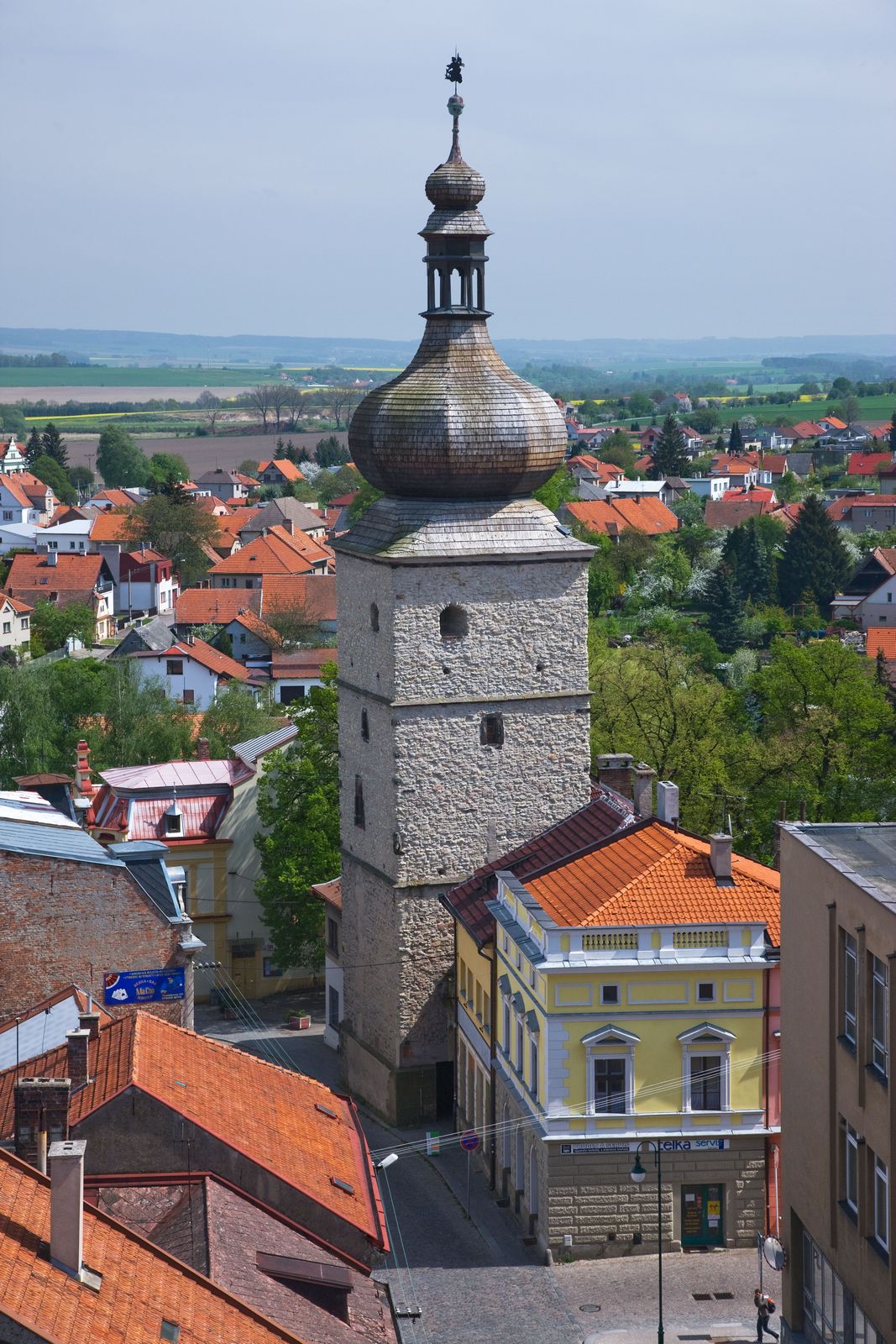 The Choceň Tower, also called Karaska is a remainder of the two-tower gate. The fourth defence storey of the tower was during baroque time replaced by the imperial dome and the fortified place in front of the gate, the main gain and smaller tower definitely disappeared in the 19th century. The Choceň Tower, in comparison with the Prague and Litomyšl Gates was spared from the restorations and preserved its original look concluding the architectural details. In addition to the fragments of the stone gargoyle in the corner (probably a rider motif) you can see the old entrance to the ambit above the gate once protected by a drawbridge. If the bridge was drawn, it fitted the space of the set-off and thus the way was safely closed.
The Choceň Tower, also called Karaska is a remainder of the two-tower gate. The fourth defence storey of the tower was during baroque time replaced by the imperial dome and the fortified place in front of the gate, the main gain and smaller tower definitely disappeared in the 19th century. The Choceň Tower, in comparison with the Prague and Litomyšl Gates was spared from the restorations and preserved its original look concluding the architectural details. In addition to the fragments of the stone gargoyle in the corner (probably a rider motif) you can see the old entrance to the ambit above the gate once protected by a drawbridge. If the bridge was drawn, it fitted the space of the set-off and thus the way was safely closed.
Jungmann´s Park
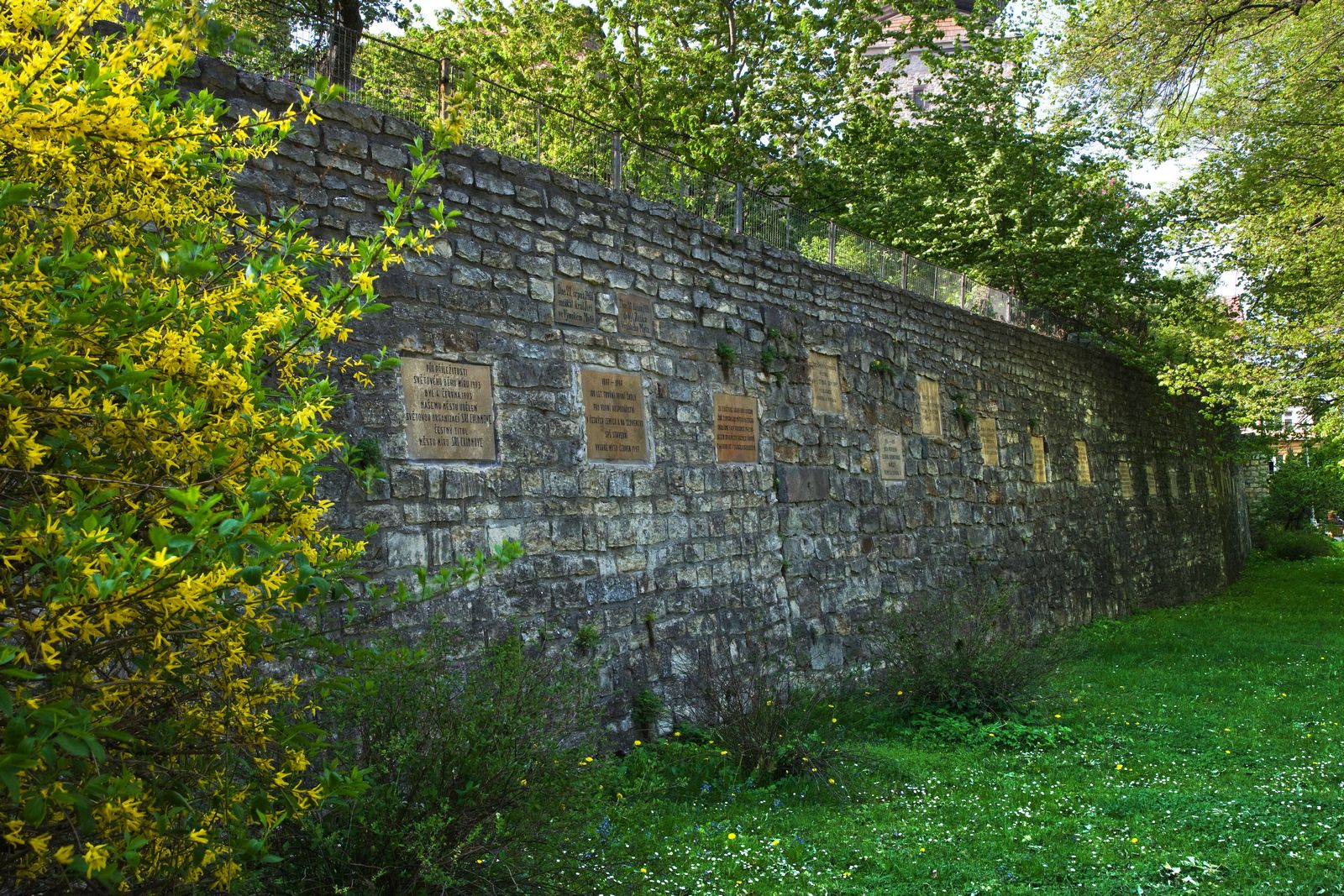 Between 1873 and 1875 the Jungmann´s Park was established for the occasion of the 100th anniversary of Josef Jungmann´s birth. The Park was founded in the area of the former rampart and moat. The whole length of the park is verged by the recent wall, which once used to be the main “bailey”. Only some original fragments were preserved of it in a short part of the recent wall which extends from the Choceň Tower to the Jungmann´s memorial (1911). Memorial tablets (the first was placed in 1912) are set into the wall as a reminder of the important events from the past and also from the modern town history. The fragments of the main town wall above the bailey may be seen from the Jungmann´s Memorial. The Memorial of soldiers perished during both World Wars is placed at the park as well. Originally it was built in 1923 by the 30th infantry regiment as remembrance of its perished soldiers during the conflict in Slovakia. Next to the Memorial you can find the restored bastion of town fortification (originally not walled, provided with memorial tablet) and behind it the visible remains of moat.
Between 1873 and 1875 the Jungmann´s Park was established for the occasion of the 100th anniversary of Josef Jungmann´s birth. The Park was founded in the area of the former rampart and moat. The whole length of the park is verged by the recent wall, which once used to be the main “bailey”. Only some original fragments were preserved of it in a short part of the recent wall which extends from the Choceň Tower to the Jungmann´s memorial (1911). Memorial tablets (the first was placed in 1912) are set into the wall as a reminder of the important events from the past and also from the modern town history. The fragments of the main town wall above the bailey may be seen from the Jungmann´s Memorial. The Memorial of soldiers perished during both World Wars is placed at the park as well. Originally it was built in 1923 by the 30th infantry regiment as remembrance of its perished soldiers during the conflict in Slovakia. Next to the Memorial you can find the restored bastion of town fortification (originally not walled, provided with memorial tablet) and behind it the visible remains of moat.
The Holy Trinity Church
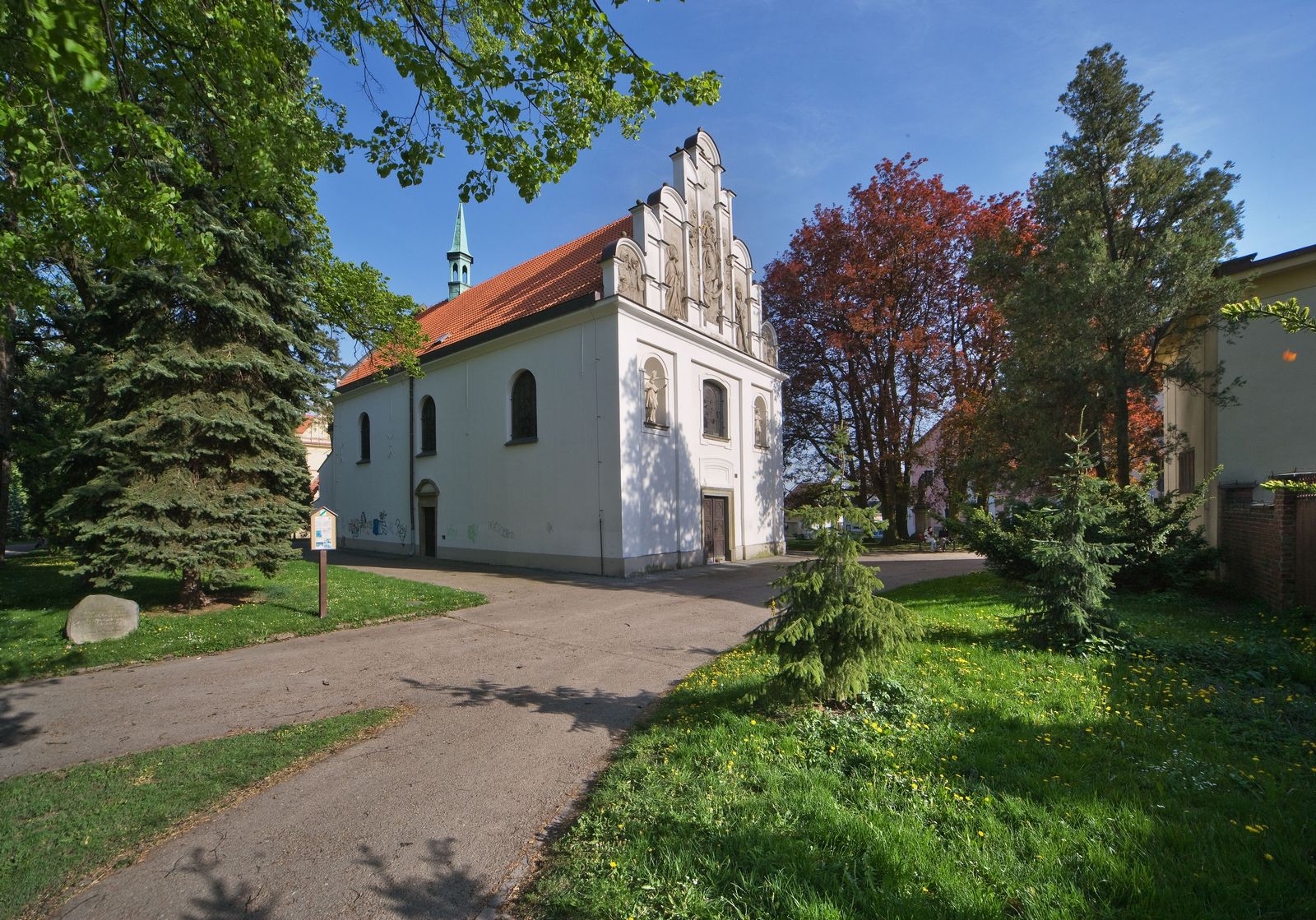 The old graveyard, which was established right after the town foundation next to St. Lawrence Cathedral, did not meet the hygienic demands of the townsmen in the 16th century. Therefore in 1540 they had decided to close it down and remove it to the clerical garden. Three years later the Holy Trinity Church was erected there. The renaissance building with gothic reminiscence was led by master Blažej from Litomyšl and in 1592 was the aisle lengthened by master Trebka. Some reconstructions were made later on, except from the aisle also the gable was rebuilt in neorenaissance style. The graveyard was definitely closed in 1906. The interior of the church is not open for the public.
The old graveyard, which was established right after the town foundation next to St. Lawrence Cathedral, did not meet the hygienic demands of the townsmen in the 16th century. Therefore in 1540 they had decided to close it down and remove it to the clerical garden. Three years later the Holy Trinity Church was erected there. The renaissance building with gothic reminiscence was led by master Blažej from Litomyšl and in 1592 was the aisle lengthened by master Trebka. Some reconstructions were made later on, except from the aisle also the gable was rebuilt in neorenaissance style. The graveyard was definitely closed in 1906. The interior of the church is not open for the public.
The Litomyšl Gate
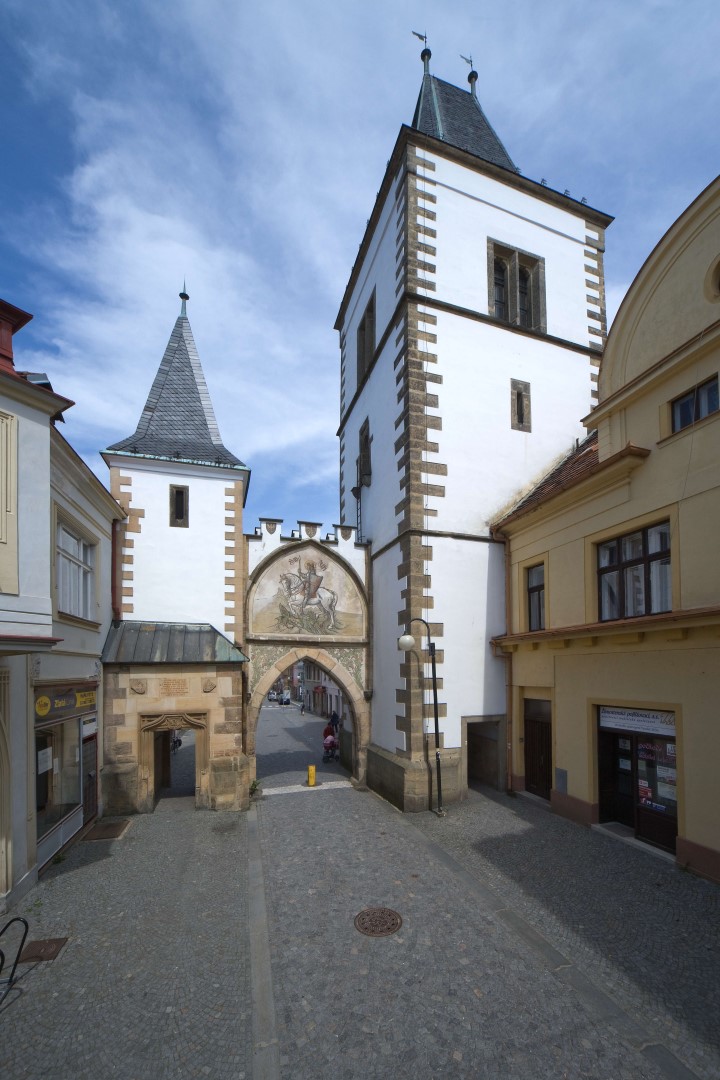 The gate did not preserve its original historical design. In the beginning of the 19th century it had been almost demolished and later the town decided to restore it between 1864 and 1867 according the idealized plans of H. Bergmann. Colour fresco from 1936 was designed by M. Aleš and it shows St. George fighting on the horse with a dragon. Today the big tower serves for the purposes of the Regional Museum of Vysoké Mýto for short-time exhibitions. In front of the gate on the left side you can have a look at the house with the sandstone lanced arch (No. 1), the remembrance of the so-called barbican. In the first half of the 15th century it was necessary to improve the town fortification system step by step, especially because of the spread of cannonade during the Hussite Wars. The barbicans built in the moat enabled high concentration of fire-arms of the defenders and at the same time they protected the main gate against direct shooting. The separated area of the barbican could be entered via today garden behind the house, after entering the first gate (which is nowadays inbuilt in the house) the path curved to the second gate (not preserved) and continued straight to the third main gate placed between two towers (recently only Litomyšl tower remained). The fragments of barbican (in fact only of its first gate) prove the unique system of the developed late gothic town fortification.
The gate did not preserve its original historical design. In the beginning of the 19th century it had been almost demolished and later the town decided to restore it between 1864 and 1867 according the idealized plans of H. Bergmann. Colour fresco from 1936 was designed by M. Aleš and it shows St. George fighting on the horse with a dragon. Today the big tower serves for the purposes of the Regional Museum of Vysoké Mýto for short-time exhibitions. In front of the gate on the left side you can have a look at the house with the sandstone lanced arch (No. 1), the remembrance of the so-called barbican. In the first half of the 15th century it was necessary to improve the town fortification system step by step, especially because of the spread of cannonade during the Hussite Wars. The barbicans built in the moat enabled high concentration of fire-arms of the defenders and at the same time they protected the main gate against direct shooting. The separated area of the barbican could be entered via today garden behind the house, after entering the first gate (which is nowadays inbuilt in the house) the path curved to the second gate (not preserved) and continued straight to the third main gate placed between two towers (recently only Litomyšl tower remained). The fragments of barbican (in fact only of its first gate) prove the unique system of the developed late gothic town fortification.
Text René Klimeš
 |
 |
 |




